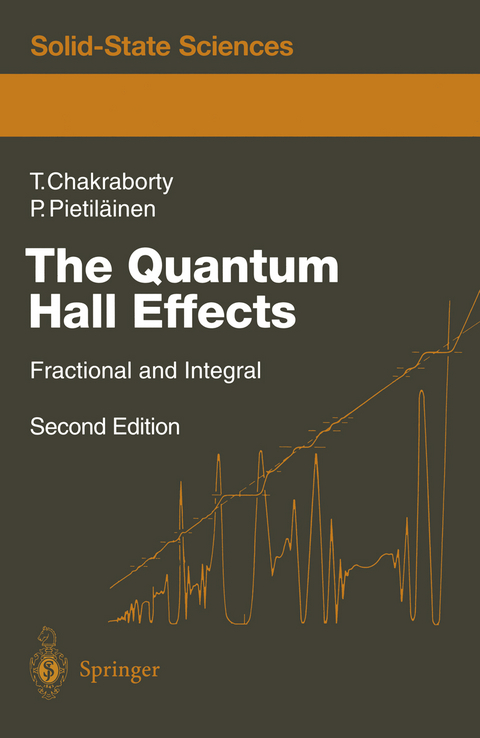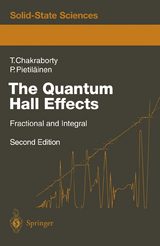The Quantum Hall Effects
Springer Berlin (Verlag)
978-3-540-58515-2 (ISBN)
The experimental discovery of the fractional quantum Hall effect (FQHE) at the end of 1981 by Tsui, Stormer and Gossard was absolutely unexpected since, at this time, no theoretical work existed that could predict new struc tures in the magnetotransport coefficients under conditions representing the extreme quantum limit. It is more than thirty years since investigations of bulk semiconductors in very strong magnetic fields were begun. Under these conditions, only the lowest Landau level is occupied and the theory predicted a monotonic variation of the resistivity with increasing magnetic field, depending sensitively on the scattering mechanism. However, the ex perimental data could not be analyzed accurately since magnetic freeze-out effects and the transitions from a degenerate to a nondegenerate system complicated the interpretation of the data. For a two-dimensional electron the positive background charge is well separated from the two gas, where dimensional system, magnetic freeze-out effects are barely visible and an analysis of the data in the extreme quantum limit seems to be easier. First measurements in this magnetic field region on silicon field-effect transistors were not successful because the disorder in these devices was so large that all electrons in the lowest Landau level were localized. Consequently, models of a spin glass and finally of a Wigner solid were developed and much effort was put into developing the technology for improving the quality of semi conductor materials and devices, especially in the field of two-dimensional electron systems.
1. Quantum Hall Effect: The Basics.- 1.1 Two-Dimensional Electron Gas.- 1.2 Electrons in a Strong Magnetic Field.- 2. Integral Quantum Hall Effect.- 2.1 Experimental Work.- 2.2 Classical Hall Effect.- 2.3 Quantum Mechanical Approach.- 2.4 Integral Quantization: Theoretical Work.- 2.5 Kubo Formula Approach.- 2.6 The Gauge Invariance Approach.- 2.7 The Topological Invariance Approach.- 3. Other Developments.- 3.1 Electron Localization in the Quantum Hall Regime.- 3.2 Renormalization Group Approach.- 3.3 Current-Carrying Edge States.- 3.4 Transport in Edge Channels and Other Topics.- 4. Fractional Quantum Hall Effect: Introduction.- 5. Ground State.- 5.1 Finite-Size Studies: Rectangular Geometry.- 5.2 Laughlin's Theory.- 5.3 Spherical Geometry.- 5.4 Monte Carlo Results.- 5.5 Reversed Spins in the Ground State.- 5.6 Finite Thickness Correction.- 5.7 Liquid-Solid Transition.- 5.8 Magnetoluminescence.- 6. Elementary Excitations.- 6.1 Quasiholes and Quasiparticles.- 6.2 Finite-Size Studies: Rectangular Geometry.- 6.3 Spin-Reversed Quasiparticles.- 6.4 Spherical Geometry.- 6.5 Monte Carlo Results.- 6.6 Experimental Investigations of the Energy Gap.- 6.7 Fractional Statistics and the Anyons.- 6.8 The Hierarchy: Higher Order Fractions.- 6.9 Tilted-Field Effects and Reversed-Spin States.- 7. Collective Modes: Intra-Landau Level.- 7.1 Finite-Size Studies: Spherical Geometry.- 7.2 Rectangular Geometry: Translational Symmetry.- 7.3 Spin Waves.- 7.4 Single Mode Approximation: Magnetorotons.- 8. Collective Modes: Inter-Landau Level.- 8.1 Kohn's Theorem.- 8.2 Filled Landau Level.- 8.3 Fractional Filling: Single Mode Approximation.- 8.4 Fractional Filling. Finite-Size Studies.- 9. Further Topics.- 9.1 Effect of Impurities.- 9.2 Quantization Condition.- 9.3 Higher Landau Levels.- 9.4Even Denominator Filling Fractions.- 9.5 Multiple Layer Systems.- 9.6 Nature of Long-Range Order in the Laughlin State.- 10. Open Problems and New Directions.- Appendices.- A The Landau Wave Function in the Symmetric Gauge.- B Kubo Formalism for the Hall Conductivity.- C The Hypernetted-Chain Primer.- D Repetition of the Intra-Landau-level Mode in the Inter-Landau-level Mode.- E Characteristic Scale Values.- References.
| Erscheint lt. Verlag | 12.7.1995 |
|---|---|
| Reihe/Serie | Springer Series in Solid-State Sciences |
| Zusatzinfo | XII, 302 p. 5 illus. |
| Verlagsort | Berlin |
| Sprache | englisch |
| Maße | 155 x 235 mm |
| Gewicht | 496 g |
| Themenwelt | Naturwissenschaften ► Physik / Astronomie ► Atom- / Kern- / Molekularphysik |
| Naturwissenschaften ► Physik / Astronomie ► Festkörperphysik | |
| Naturwissenschaften ► Physik / Astronomie ► Thermodynamik | |
| Technik ► Maschinenbau | |
| Schlagworte | energy gap • fractionally charged quasiparticles • Hall Effect • integral and fractional two-dimensional electron g • integral and fractional two-dimensional electron gas • Magnetic field • Mony-electron ground state • Quanten-Hall-Effekt • Quantum Hall Effect |
| ISBN-10 | 3-540-58515-X / 354058515X |
| ISBN-13 | 978-3-540-58515-2 / 9783540585152 |
| Zustand | Neuware |
| Haben Sie eine Frage zum Produkt? |
aus dem Bereich




